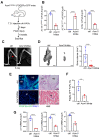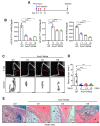AAV-Mediated Targeting of the Activin A-ACVR1R206H Signaling in Fibrodysplasia Ossificans Progressiva
- PMID: 37759764
- PMCID: PMC10526456
- DOI: 10.3390/biom13091364
AAV-Mediated Targeting of the Activin A-ACVR1R206H Signaling in Fibrodysplasia Ossificans Progressiva
Abstract
Fibrodysplasia ossificans progressiva (FOP) is an ultra-rare genetic disorder characterized by progressive disabling heterotopic ossification (HO) at extra-skeletal sites. Here, we developed adeno-associated virus (AAV)-based gene therapy that suppresses trauma-induced HO in FOP mice harboring a heterozygous allele of human ACVR1R206H (Acvr1R206H/+) while limiting the expression in non-skeletal organs such as the brain, heart, lung, liver, and kidney. AAV gene therapy carrying the combination of codon-optimized human ACVR1 (ACVR1opt) and artificial miRNAs targeting Activin A and its receptor ACVR1R206H ablated the aberrant activation of BMP-Smad1/5 signaling and the osteogenic differentiation of Acvr1R206H/+ skeletal progenitors. The local delivery of AAV gene therapy to HO-causing cells in the skeletal muscle resulted in a significant decrease in endochondral bone formation in Acvr1R206H/+ mice. These mice showed little to no expression in a major AAV-targeted organ, the liver, due to liver-abundant miR-122-mediated repression. Thus, AAV gene therapy is a promising therapeutic strategy to explore in suppressing HO in FOP.
Keywords: AAV; ACVR1; Activin A; fibrodysplasia ossificans progressiva; gene therapy; heterotopic ossificans.
Conflict of interest statement
G.G. and J.H.S. have submitted a patent application concerning the methodology described in this study. G.G. and J.H.S. are scientific co-founders of AAVAA Therapeutics and hold equity in this company. G.G. is also a scientific co-founder of Voyager Therapeutics and Aspa Therapeutics and holds equity in these companies. G.G. is an inventor on patents with potential royalties licensed to Voyager Therapeutics, Adrenas Therapeutics, Aspa Therapeutics Inc., and other biopharmaceutical companies. F.S.K. is the founder and past-President of the International Clinical Council (ICC) on FOP. F.S.K. serves in a volunteer capacity on the registry advisory board of the IFOPA. F.S.K. is an investigator on clinical trials sponsored by Clementia, an Ipsen company, and by Regeneron Pharmaceuticals.
Figures






Similar articles
-
The ACVR1 R206H mutation found in fibrodysplasia ossificans progressiva increases human induced pluripotent stem cell-derived endothelial cell formation and collagen production through BMP-mediated SMAD1/5/8 signaling.Stem Cell Res Ther. 2016 Aug 17;7(1):115. doi: 10.1186/s13287-016-0372-6. Stem Cell Res Ther. 2016. PMID: 27530160 Free PMC article.
-
Suppression of heterotopic ossification in fibrodysplasia ossificans progressiva using AAV gene delivery.Nat Commun. 2022 Oct 19;13(1):6175. doi: 10.1038/s41467-022-33956-9. Nat Commun. 2022. PMID: 36258013 Free PMC article.
-
ACVR1R206H receptor mutation causes fibrodysplasia ossificans progressiva by imparting responsiveness to activin A.Sci Transl Med. 2015 Sep 2;7(303):303ra137. doi: 10.1126/scitranslmed.aac4358. Sci Transl Med. 2015. PMID: 26333933 Free PMC article.
-
The obligatory role of Activin A in the formation of heterotopic bone in Fibrodysplasia Ossificans Progressiva.Bone. 2018 Apr;109:210-217. doi: 10.1016/j.bone.2017.06.011. Epub 2017 Jun 16. Bone. 2018. PMID: 28629737 Free PMC article. Review.
-
How Activin A Became a Therapeutic Target in Fibrodysplasia Ossificans Progressiva.Biomolecules. 2024 Jan 12;14(1):101. doi: 10.3390/biom14010101. Biomolecules. 2024. PMID: 38254701 Free PMC article. Review.
Cited by
-
The Intra-Articular Delivery of a Low-Dose Adeno-Associated Virus-IL-1 Receptor Antagonist Vector Alleviates the Progress of Arthritis in an Osteoarthritis Rat Model.Pharmaceutics. 2024 Nov 25;16(12):1518. doi: 10.3390/pharmaceutics16121518. Pharmaceutics. 2024. PMID: 39771498 Free PMC article.
-
The role of miRNAs as biomarkers in heterotopic ossification.EFORT Open Rev. 2024 Dec 2;9(12):1120-1133. doi: 10.1530/EOR-22-0100. EFORT Open Rev. 2024. PMID: 39620561 Free PMC article. Review.
-
Advancements in mechanisms and drug treatments for fibrodysplasia ossificans progressiva.J Zhejiang Univ Sci B. 2025 Apr 23;26(4):317-332. doi: 10.1631/jzus.B2300779. J Zhejiang Univ Sci B. 2025. PMID: 40274382 Free PMC article. Review.
-
Molecular Developmental Biology of Fibrodysplasia Ossificans Progressiva: Measuring the Giant by Its Toe.Biomolecules. 2024 Aug 15;14(8):1009. doi: 10.3390/biom14081009. Biomolecules. 2024. PMID: 39199396 Free PMC article. Review.
-
Development of AAV-Mediated Gene Therapy Approaches to Treat Skeletal Diseases.Hum Gene Ther. 2024 May;35(9-10):317-328. doi: 10.1089/hum.2024.022. Epub 2024 Apr 8. Hum Gene Ther. 2024. PMID: 38534217 Free PMC article. Review.
References
-
- Pignolo R.J., Hsiao E.C., Baujat G., Lapidus D., Sherman A., Kaplan F.S. Prevalence of fibrodysplasia ossificans progressiva (FOP) in the United States: Estimate from three treatment centers and a patient organization. Orphanet J. Rare Dis. 2021;16:350. doi: 10.1186/s13023-021-01983-2. - DOI - PMC - PubMed
Publication types
MeSH terms
Substances
Grants and funding
LinkOut - more resources
Full Text Sources
Other Literature Sources
Molecular Biology Databases

